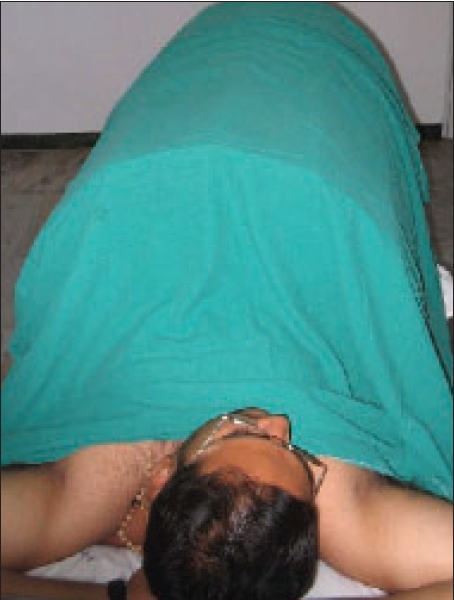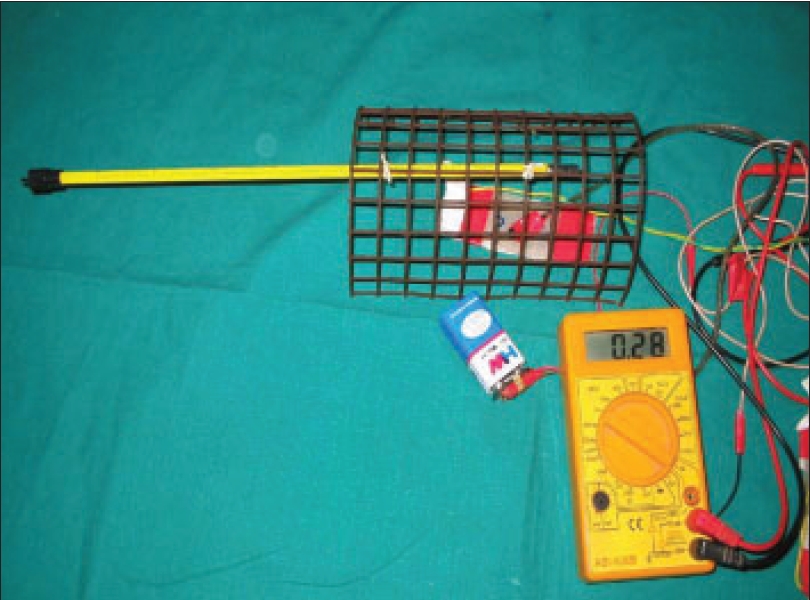Translate this page into:
Exploiting the igloo principle and greenhouse effect to regulate humidity and temperature
2 Department of Physics, PSG College of Technology, Peelamedu, Coimbatore, India
Correspondence Address:
C R Srinivas
Department of Dermatology, PSG Hospitals, Peelamedu, Coimbatore - 641 004, Tamil Nadu
India
| How to cite this article: Prabhu KS, Srinivas C R, Nair S, Sundaram SV, Thirumurthy M. Exploiting the igloo principle and greenhouse effect to regulate humidity and temperature. Indian J Dermatol Venereol Leprol 2006;72:361-363 |
Abstract
Background: Toxic epidermal necrolysis can be fatal and nursing care with careful monitoring of temperature and humidity can improve survival rate. We adapted the greenhouse and igloo principle using a common hood to monitor the temperature and humidity. Methods: A small heater with a regulator was placed in a mini hood and temperature was recorded inside the uncovered hood and hood covered with green cloth and aluminium foil separately. The regular hood was placed over a volunteer and the temperature was measured inside the open hood and hood covered with green cloth and aluminium foil separately. The relative humidity was also monitored using Zeal mercury dry - wet bulb hygrometer. Results: Temperature increase was most marked in the foil-covered hood followed by cloth-covered hood, both with the heater and the volunteer. Similarly, in the volunteer study, the humidity was best maintained inside the aluminium foil-covered hood. Conclusion: We recommend the use of regular hood with suitable cover to monitor the humidity and temperature of patients with toxic epidermal necrolysis.



 |
| Human volunteer inside the hood covered with green cloth |
 |
| Human volunteer inside the hood covered with green cloth |
 |
| Open hood with heater and thermometer |
 |
| Open hood with heater and thermometer |
Introduction
It is recommended that the surrounding temperature of the patient with toxic epidermal necrolysis (TEN) should be maintained at 32°C.[1] Maintaining higher humidity will decrease evaporation and thus decrease heat loss and also promote wound healing. In India air-conditioners (for warming) and humidifiers are not available in most of the centers. A patient with TEN loses heat and water constantly from the body. We have applied the greenhouse and igloo principle to trap the heat lost by radiation, conduction, convection and evaporation, and also to limit the fluid loss by evaporation.
Methods
The studies were initially performed on an experimental model and subsequently on a human volunteer. The electronic circuit for driving the heater used in the experimental model is based on the switching principle. The step-down transformer first reduces the mains supply voltage from the standard 230V AC to a convenient 10V AC. The triggering circuit is adapted from a standard solid-state dimmer circuit used to dim lamps. The circuit turns on the heater during a part of every half-cycle (10 ms) of the AC. Using this method, it is possible to control the temperature of the heater by adjusting the time (0-10 ms) for which the heater receives power during each half-cycle.
The temperature and relative humidity of the area around the patient within the hood and the room temperature were measured using a Zeal mercury dry-wet bulb hygrometer. The temperature of the heater was measured using a solid state temperature sensor LM35 and a 3½ digit, digital multimeter. The temperature sensor was provided with a 9v DC supply from a battery. The output of the sensor was 10 mV for every degree celsius. The heater was placed in the hemi-cylindrical hood (length-15 cm, radius-5.5 cm) made of metal wires. The temperature within the hood was measured by a mercury thermometer, the bulb of which was tied to the inner surface of the hemi-cylindrical hood [Figure - 1]. The heater was placed on the table and covered by the hood. The temperature of the heater was monitored using the digital multimeter with the probe which was taped to the heater. The temperature inside and outside the hood was recorded at the beginning of the experiment and at 15-minute intervals for one hour. Humidity was not measured during this experiment. The experiment, as described, was repeated with the hood covered with a green cloth initially and with aluminium foil subsequently.
While experimenting on a human volunteer, the temperature and humidity in the hood were recorded and described below. A hemi-cylindrical hood (length 85 cm, radius 45 cm) made of metal rods was used. The volunteer (KP) in undergarment was made to lie on the bed and the hood was placed over his body. The hygrometer was placed within the hood. The body temperature and room temperature was measured by digital multimeter and probe as described earlier. The temperature was recorded with open hood at the beginning and at 15-minute intervals for one hour. Similarly, the experiment was repeated with hood covered with green cloth [Figure - 2] and aluminium foil subsequently.
Results
In the experimental model, there was no difference in the temperature within and outside the open hood, but there was an increase in the hood temperature when covered by cloth and aluminium foil. The temperature of the heater was also increased within the covered hood. The increase was more marked within the foil-covered hood [Table - 1].
In the study with the volunteer, the temperature within the open hood was the same as that of the outside temperature, but there was an increase in the hood temperature in the covered hoods. The temperature increase was more in the hood covered by aluminium foil [Table - 2]. The relative humidity in the cloth-covered hood was 81% and it decreased to 73% at the end of one hour whereas the humidity was maintained at about 78% in the aluminium foil-covered hood [Table - 2].
Discussion
TEN has a mortality of 25 to 35%.[2] Barrier nursing, maintenance of surrounding temperature and humidity may improve the eventual prognosis. The care is best administered in a modern burn unit[3] with the facility of barrier nursing, maintenance of humidity and body temperature. In India, most of the centers do not have a separate burn ward and the most of the wards even with air-conditioners do not have the facility to maintain higher temperature. The common room heaters with coil and fan may heat the room but will generate dry air, which will reduce the humidity and enhance evaporation rates from moist surfaces. In addition, most of these heaters do not have a thermostat control. Temperature in the igloo and inside the greenhouse is maintained by preventing heat loss generated inside. In the greenhouse the heat is liberated by plants and the earth and in the igloo by the human body and lamp. We use the hood to utilize the principle of the greenhouse and the igloo. The hood also permits less handling of the patient and avoids the necessity of covering the patient directly with cloth. Instead the hood is covered with a sheet to offer privacy. Our study demonstrates that the same hood can also be used to maintain the ambient temperature at a desired level and to maintain the humidity. The hood retains and reflects the heat generated by the body and prevents dispersion of water vapor liberated both by sweating and the raw area of the body.
Depending on the patient′s core body temperature, which may be increased during secondary infection, the hood can be partially uncovered at the top to lower the temperature as the hot air rises above. Both the temperature and humidity can be monitored along with pulse, blood pressure and respiratory rate at hourly intervals. To conclude, we recommend the use of covered hood to provide privacy to the patient and also to regulate the temperature and humidity around the patient during management of TEN, exfoliative dermatitis and other vesiculo-bullous disorders.
| 1. |
Ghislain PD, Roujeau JC. Treatment of severe drug reactions: Stevens-Johnson syndrome, toxic epidermal necrolysis and hypersensitivity syndrome. Dermatol Online J 2002;8:5.
[Google Scholar]
|
| 2. |
Revuz J, Penso D, Roujeau JC, Guillaume JC, Payne CR, Wechsler J, et al . Toxic epidermal necrolysis. Clinical findings and prognosis factors in 87 patients. Arch Dermatol 1987;123: 1160-5.
[Google Scholar]
|
| 3. |
McGee T, Munster A. Toxic epidermal necrolysis syndrome: Mortality rate reduced with early referral to regional burn center. Plast Reconstr Surg 1998;102:1018-22.
[Google Scholar]
|
Fulltext Views
1,615
PDF downloads
1,067





